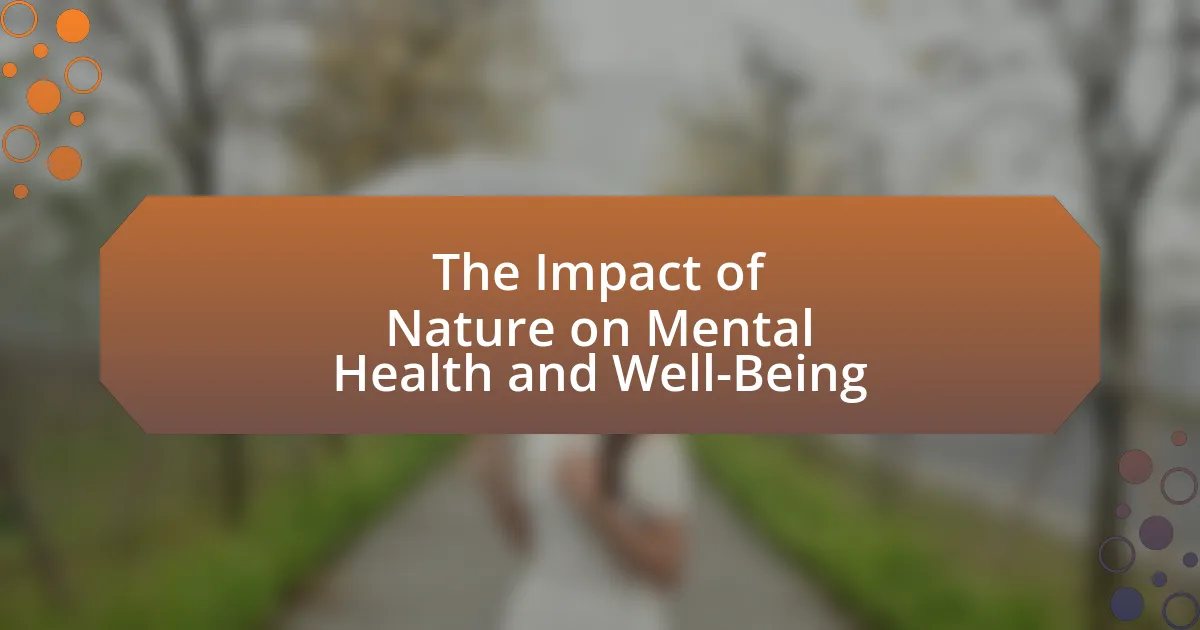The article examines the significant impact of nature on mental health and well-being, highlighting how exposure to natural environments can reduce stress, anxiety, and depression while enhancing mood and cognitive function. Key studies, including those published in “Environmental Science & Technology” and “Health & Place,” demonstrate that individuals who engage with nature report improved emotional well-being and lower cortisol levels. The article also explores various nature-based therapies, the psychological mechanisms behind nature’s benefits, and the specific populations that gain the most from these interactions, such as children, the elderly, and urban residents. Additionally, it addresses barriers to accessing natural environments and suggests practical ways individuals can incorporate nature into their daily lives to maximize mental health benefits.

What is the Impact of Nature on Mental Health and Well-Being?
Nature has a significant positive impact on mental health and well-being. Exposure to natural environments has been shown to reduce stress, anxiety, and depression while enhancing mood and cognitive function. Research published in the journal “Environmental Science & Technology” by Bratman et al. (2015) found that individuals who walked in natural settings reported lower levels of rumination and improved emotional well-being compared to those who walked in urban environments. Additionally, a meta-analysis in “Health & Place” by Bowler et al. (2010) indicated that green spaces contribute to increased physical activity, which is closely linked to improved mental health outcomes. These findings underscore the importance of nature in promoting psychological resilience and overall well-being.
How does exposure to nature influence mental health?
Exposure to nature significantly improves mental health by reducing stress, anxiety, and depression. Studies indicate that spending time in natural environments can lower cortisol levels, which are associated with stress. For instance, research published in the journal “Environmental Science & Technology” by Bratman et al. (2015) found that participants who walked in a natural setting reported lower levels of rumination and improved mood compared to those who walked in urban environments. Additionally, a meta-analysis in “Health & Place” by Bowler et al. (2010) demonstrated that green spaces are linked to enhanced psychological well-being, highlighting the therapeutic effects of nature on mental health.
What psychological mechanisms are involved in nature’s impact on mental health?
Nature positively impacts mental health through several psychological mechanisms, including stress reduction, attention restoration, and enhanced mood. Exposure to natural environments has been shown to lower cortisol levels, which are associated with stress, thereby promoting relaxation and reducing anxiety. The Attention Restoration Theory posits that natural settings help restore cognitive resources depleted by mental fatigue, improving focus and mental clarity. Additionally, nature exposure can elevate mood by increasing feelings of happiness and well-being, as evidenced by studies indicating that individuals who spend time in green spaces report lower levels of depression and higher life satisfaction. These mechanisms collectively illustrate how interaction with nature fosters psychological resilience and overall mental health.
How do different environments affect emotional well-being?
Different environments significantly affect emotional well-being by influencing stress levels, mood, and overall mental health. Natural environments, such as parks and forests, have been shown to reduce stress and anxiety, improve mood, and enhance cognitive function. For instance, a study published in the journal Environmental Science & Technology found that individuals who spent time in natural settings reported lower levels of cortisol, a stress hormone, compared to those in urban environments. Additionally, exposure to nature has been linked to increased feelings of happiness and life satisfaction, as evidenced by research from the University of Exeter, which found that people living in greener areas experienced better mental health outcomes. Conversely, urban environments, characterized by noise, pollution, and overcrowding, can lead to heightened stress and anxiety levels, negatively impacting emotional well-being.
Why is nature considered a therapeutic tool?
Nature is considered a therapeutic tool because it has been shown to reduce stress, anxiety, and depression while enhancing overall well-being. Research indicates that exposure to natural environments can lower cortisol levels, which are associated with stress, and improve mood and cognitive function. For instance, a study published in the journal “Environmental Science & Technology” by Bratman et al. (2015) found that individuals who walked in a natural setting reported lower levels of rumination and improved emotional well-being compared to those who walked in an urban environment. This evidence supports the notion that nature serves as a powerful resource for mental health improvement.
What types of nature-based therapies exist?
Nature-based therapies include ecotherapy, horticultural therapy, animal-assisted therapy, forest bathing, and wilderness therapy. Ecotherapy involves therapeutic practices in natural settings to improve mental health, supported by studies showing reduced anxiety and depression in participants. Horticultural therapy uses gardening activities to enhance emotional well-being, with research indicating that engaging with plants can lower stress levels. Animal-assisted therapy incorporates animals to provide comfort and support, which has been shown to reduce feelings of loneliness and increase social interaction. Forest bathing, or Shinrin-yoku, emphasizes immersive experiences in forests, linked to lower cortisol levels and improved mood. Wilderness therapy combines outdoor adventure with therapeutic interventions, demonstrating effectiveness in treating behavioral issues and promoting personal growth. Each of these therapies is grounded in evidence that highlights their positive impact on mental health and well-being.
How effective are these therapies in improving mental health outcomes?
Therapies that incorporate nature, such as ecotherapy and nature-based interventions, are highly effective in improving mental health outcomes. Research indicates that individuals who engage in nature therapy report significant reductions in symptoms of anxiety, depression, and stress. For instance, a study published in the Journal of Environmental Psychology found that spending time in natural environments can lead to a 20% reduction in cortisol levels, a key stress hormone, thereby enhancing overall mental well-being. Additionally, a meta-analysis in the International Journal of Environmental Research and Public Health highlighted that nature-based therapies can improve mood and increase feelings of relaxation and connectedness. These findings underscore the effectiveness of nature therapies in fostering positive mental health outcomes.
What are the key benefits of connecting with nature?
Connecting with nature provides significant benefits for mental health and well-being, including reduced stress, improved mood, and enhanced cognitive function. Research indicates that spending time in natural environments lowers cortisol levels, which are associated with stress, and promotes feelings of relaxation and happiness. A study published in the journal “Environmental Science & Technology” found that individuals who engage with nature experience a 20% reduction in stress levels and a notable increase in overall life satisfaction. Furthermore, exposure to green spaces has been linked to improved attention and memory, as demonstrated in research by Berman et al. (2012), which showed that nature walks can enhance cognitive performance by restoring mental fatigue.
How does nature exposure reduce stress and anxiety?
Nature exposure reduces stress and anxiety by promoting physiological and psychological relaxation. Studies indicate that spending time in natural environments lowers cortisol levels, which is a key stress hormone, and enhances mood through increased serotonin production. For instance, research published in the journal “Environmental Science & Technology” by Bratman et al. (2015) found that participants who walked in a natural setting reported lower levels of rumination and negative affect compared to those who walked in an urban environment. Additionally, exposure to nature has been linked to improved attention and cognitive function, further contributing to reduced anxiety levels.
What role does nature play in enhancing mood and cognitive function?
Nature plays a significant role in enhancing mood and cognitive function by providing restorative environments that reduce stress and improve mental clarity. Research indicates that exposure to natural settings can lower cortisol levels, which are associated with stress, and enhance overall emotional well-being. A study published in the journal “Environmental Science & Technology” by Bratman et al. (2015) found that individuals who walked in natural environments reported lower levels of rumination and improved mood compared to those who walked in urban settings. Additionally, nature exposure has been linked to increased attention capacity and cognitive performance, as evidenced by a study in “Psychological Science” by Berman et al. (2008), which demonstrated that participants who engaged with nature performed better on cognitive tasks than those who did not.
How can individuals incorporate nature into their daily lives?
Individuals can incorporate nature into their daily lives by engaging in outdoor activities such as walking, gardening, or simply spending time in green spaces. Research indicates that spending time in nature can reduce stress, improve mood, and enhance overall mental well-being. A study published in the journal Environmental Science & Technology found that individuals who spent at least two hours a week in nature reported significantly better health and well-being. By integrating these activities into their routines, individuals can foster a deeper connection with the natural environment, which is essential for mental health.
What barriers exist to accessing natural environments?
Barriers to accessing natural environments include physical, economic, and social factors. Physical barriers often involve the lack of nearby green spaces, inadequate transportation options, or challenging terrain that makes access difficult. Economic barriers can manifest as high costs associated with travel to natural areas or fees for entry into parks and recreational sites. Social barriers may include cultural perceptions that discourage certain groups from engaging with nature or a lack of community support for outdoor activities. According to a study published in the journal “Environmental Research” by researchers from the University of Exeter, these barriers significantly limit individuals’ ability to benefit from the mental health advantages associated with nature exposure.
What specific populations benefit from nature’s impact on mental health?
Specific populations that benefit from nature’s impact on mental health include children, individuals with mental health disorders, the elderly, and urban residents. Research indicates that children experience improved mood and cognitive function when exposed to natural environments, as shown in studies highlighting increased attention and reduced symptoms of ADHD. Individuals with mental health disorders, such as anxiety and depression, often report significant reductions in symptoms after spending time in nature, supported by findings from the University of Essex that demonstrate a 71% improvement in mental well-being after nature exposure. The elderly benefit from nature through enhanced social interaction and reduced feelings of loneliness, as evidenced by studies showing that green spaces promote community engagement. Urban residents, facing high levels of stress and anxiety due to city living, find relief in nature, with studies indicating that access to parks and green spaces can lower cortisol levels and improve overall mental health.
How does nature affect children’s mental health?
Nature positively affects children’s mental health by reducing stress, enhancing mood, and improving cognitive function. Exposure to natural environments has been linked to lower levels of anxiety and depression in children, as evidenced by a study published in the journal “Environmental Health Perspectives,” which found that children living in greener areas exhibited better mental health outcomes. Additionally, interactions with nature can foster creativity and promote physical activity, both of which contribute to overall psychological well-being.
What are the long-term benefits of nature exposure for children?
Long-term exposure to nature significantly enhances children’s mental health and well-being. Research indicates that children who regularly engage with natural environments exhibit reduced symptoms of anxiety and depression, improved attention spans, and enhanced cognitive functioning. A study published in the journal “Environmental Health Perspectives” found that children living in greener areas showed lower levels of behavioral problems and higher levels of self-discipline. Furthermore, consistent interaction with nature fosters creativity and promotes physical health, as children are more likely to engage in outdoor activities, leading to better overall fitness and reduced obesity rates. These benefits collectively contribute to healthier emotional and psychological development in children over time.
How can parents encourage outdoor activities for their children?
Parents can encourage outdoor activities for their children by creating a structured schedule that includes regular outdoor playtime. Research indicates that children who engage in outdoor activities experience improved mental health and well-being, as exposure to nature has been linked to reduced stress and anxiety levels. For instance, a study published in the journal “Environmental Science & Technology” found that spending time in green spaces can significantly enhance mood and cognitive function in children. By organizing family outings to parks, nature trails, or sports activities, parents can foster a love for the outdoors and promote physical health, which is essential for overall well-being.
What is the impact of nature on elderly mental health?
Nature positively impacts elderly mental health by reducing symptoms of anxiety and depression. Studies indicate that exposure to natural environments can enhance mood and cognitive function in older adults. For instance, research published in the Journal of Environmental Psychology found that spending time in green spaces significantly lowers stress levels and improves overall well-being among seniors. Additionally, a systematic review in the International Journal of Environmental Research and Public Health highlighted that nature-based interventions, such as gardening and nature walks, lead to improved mental health outcomes for the elderly. These findings underscore the importance of nature in promoting mental health in older populations.
How does nature help combat loneliness and depression in older adults?
Nature helps combat loneliness and depression in older adults by providing opportunities for social interaction, physical activity, and mental stimulation. Engaging with natural environments has been shown to reduce feelings of isolation and enhance mood. For instance, studies indicate that older adults who participate in community gardening or nature walks report lower levels of depression and increased social connections. Research published in the Journal of Environmental Psychology found that exposure to green spaces significantly improves psychological well-being, particularly in older populations. Additionally, nature’s calming effects can lower stress levels, further alleviating symptoms of depression.
What community programs promote nature engagement for seniors?
Community programs that promote nature engagement for seniors include local gardening clubs, nature walks organized by community centers, and senior-focused outdoor education programs. These initiatives encourage seniors to participate in activities that connect them with nature, which has been shown to enhance mental health and well-being. For instance, studies indicate that engaging with nature can reduce feelings of loneliness and depression among older adults, thereby improving their overall quality of life. Programs like the National Park Service’s “Every Kid in a Park” initiative also provide opportunities for seniors to explore natural spaces, reinforcing the positive impact of nature on mental health.
How does nature influence mental health in urban populations?
Nature positively influences mental health in urban populations by reducing stress, anxiety, and depression. Access to green spaces, such as parks and gardens, has been shown to enhance mood and promote psychological well-being. A study published in the journal “Environmental Science & Technology” found that individuals living near green spaces reported lower levels of mental distress and higher life satisfaction. Furthermore, exposure to natural environments can improve cognitive function and attention restoration, as evidenced by research from the University of Illinois, which demonstrated that interaction with nature leads to improved focus and reduced mental fatigue.
What challenges do urban dwellers face in accessing nature?
Urban dwellers face significant challenges in accessing nature, primarily due to limited green spaces, urban density, and infrastructural barriers. Many cities have insufficient parks or natural areas, with studies indicating that urban areas often allocate less than 10% of their land to green spaces, which restricts residents’ opportunities for outdoor activities. Additionally, high population density can lead to overcrowded parks, diminishing the quality of the nature experience. Furthermore, urban infrastructure, such as roads and buildings, often creates physical barriers that make it difficult for residents to reach natural areas, particularly for marginalized communities who may lack transportation options. These factors collectively hinder urban dwellers’ ability to engage with nature, which is essential for mental health and well-being.
How can urban planning enhance green spaces for mental well-being?
Urban planning can enhance green spaces for mental well-being by integrating parks, gardens, and natural landscapes into urban environments. Research indicates that access to green spaces reduces stress, anxiety, and depression, promoting overall mental health. For instance, a study published in the journal “Environmental Science & Technology” found that individuals living near green spaces reported better mental health outcomes and lower levels of psychological distress. Additionally, urban planners can design these spaces to be accessible and inclusive, encouraging community interaction and physical activity, which further supports mental well-being.

What scientific research supports the connection between nature and mental health?
Scientific research consistently supports the connection between nature and mental health, demonstrating that exposure to natural environments can significantly reduce stress, anxiety, and depression. A notable study published in the journal “Environmental Science & Technology” by Bratman et al. (2015) found that individuals who walked in natural settings reported lower levels of rumination and improved mood compared to those who walked in urban environments. Additionally, research by Kaplan and Kaplan (1989) introduced the Attention Restoration Theory, which posits that nature helps restore cognitive function and reduce mental fatigue. Furthermore, a meta-analysis by Bowler et al. (2010) indicated that green spaces are associated with improved mental well-being, highlighting the importance of nature in promoting psychological health.
What studies have been conducted on nature’s effects on mental health?
Numerous studies have been conducted on nature’s effects on mental health, demonstrating significant positive impacts. For instance, a study published in the journal “Environmental Science & Technology” by Bratman et al. (2015) found that individuals who walked in natural environments reported lower levels of rumination and improved mood compared to those who walked in urban settings. Another research conducted by Kaplan and Kaplan (1989) highlighted that exposure to natural environments can enhance cognitive functioning and reduce stress. Additionally, a meta-analysis by Bowler et al. (2010) reviewed multiple studies and concluded that green spaces are associated with improved mental well-being, including reduced anxiety and depression. These findings collectively underscore the beneficial relationship between nature and mental health.
What methodologies are commonly used in this research?
Common methodologies used in research on the impact of nature on mental health and well-being include quantitative surveys, qualitative interviews, and experimental studies. Quantitative surveys often measure psychological outcomes using standardized scales, such as the Perceived Stress Scale or the Warwick-Edinburgh Mental Well-being Scale, to assess the relationship between nature exposure and mental health metrics. Qualitative interviews provide in-depth insights into personal experiences and perceptions regarding nature’s effects on well-being. Experimental studies may involve controlled environments where participants engage with natural settings to observe changes in mood or stress levels, often supported by physiological measures like heart rate variability. These methodologies collectively contribute to a comprehensive understanding of how nature influences mental health.
What findings have emerged from recent studies?
Recent studies indicate that exposure to nature significantly enhances mental health and well-being. Research published in the journal “Environmental Science & Technology” by Bratman et al. (2015) found that individuals who walked in natural environments reported lower levels of rumination and improved mood compared to those who walked in urban settings. Additionally, a meta-analysis in “Health & Place” by Bowler et al. (2010) revealed that green spaces are associated with reduced stress and anxiety levels. These findings underscore the therapeutic benefits of nature, suggesting that regular interaction with natural environments can lead to improved psychological outcomes.
How do cultural perspectives shape the understanding of nature’s impact?
Cultural perspectives significantly shape the understanding of nature’s impact on mental health and well-being by influencing beliefs, values, and practices related to the natural environment. For instance, Indigenous cultures often view nature as a living entity with which they have a reciprocal relationship, leading to practices that promote environmental stewardship and mental wellness through connection to the land. In contrast, Western cultures may prioritize nature’s utility, focusing on its benefits for recreation and therapy, which can lead to a more transactional relationship with the environment. Research indicates that these differing perspectives affect how individuals engage with nature, with studies showing that those who perceive nature as sacred or integral to their identity report higher levels of mental well-being (Kumar & Kumar, 2020, “Cultural Perspectives on Nature and Mental Health,” Journal of Environmental Psychology). Thus, cultural frameworks not only shape individual experiences of nature but also inform broader societal approaches to mental health interventions that incorporate natural settings.
What differences exist in nature engagement across cultures?
Differences in nature engagement across cultures manifest in varying practices, beliefs, and values associated with the natural environment. For instance, Indigenous cultures often emphasize a spiritual connection to nature, viewing it as a living entity deserving respect, which contrasts with Western cultures that may prioritize nature for recreational or economic purposes. Research indicates that cultures with strong communal ties, such as many Indigenous groups, engage in collective activities like traditional ecological knowledge sharing, which fosters a deeper relationship with nature. In contrast, urbanized societies may exhibit a more transactional relationship with nature, focusing on individual experiences such as hiking or gardening. Studies, such as those by Kaplan and Kaplan (1989), highlight that cultural context significantly influences how individuals perceive and interact with natural environments, affecting mental health outcomes and overall well-being.
How do cultural beliefs influence mental health practices related to nature?
Cultural beliefs significantly influence mental health practices related to nature by shaping perceptions of the natural environment and its therapeutic benefits. For instance, in many Indigenous cultures, nature is viewed as a sacred entity that fosters spiritual well-being, leading to practices that incorporate natural elements in healing rituals. Research indicates that cultures emphasizing a strong connection to nature often promote outdoor activities, such as forest bathing in Japan, which has been shown to reduce stress and improve mood. Additionally, cultural narratives around nature can dictate the types of mental health interventions utilized, with some communities favoring holistic approaches that integrate traditional ecological knowledge. This interplay between cultural beliefs and mental health practices underscores the importance of context in understanding how nature is utilized for psychological healing.
What future research directions are needed in this field?
Future research directions in the field of the impact of nature on mental health and well-being should focus on longitudinal studies that assess the long-term effects of nature exposure on mental health outcomes. Such studies can provide insights into causality and the sustainability of benefits over time. Additionally, research should explore the mechanisms through which nature influences mental health, including physiological, psychological, and social factors. Investigating the effects of different types of natural environments, such as urban green spaces versus wilderness areas, can also yield valuable data. Furthermore, studies should examine the role of individual differences, such as age, gender, and cultural background, in moderating the relationship between nature exposure and mental health. These directions are supported by existing literature that highlights the need for comprehensive understanding in this area to inform public health policies and interventions.

How can individuals maximize the benefits of nature for mental health?
Individuals can maximize the benefits of nature for mental health by engaging in regular outdoor activities, such as walking, hiking, or gardening. Research indicates that spending time in natural environments can reduce symptoms of anxiety and depression; for instance, a study published in the journal Environmental Science & Technology found that participants who spent at least 120 minutes per week in nature reported significantly better health and well-being. Additionally, incorporating mindfulness practices while in nature, such as focusing on sensory experiences, can enhance the positive effects on mental health.
What practical tips can enhance nature experiences for better mental well-being?
Engaging in nature experiences can significantly enhance mental well-being by incorporating specific practices. Spending time in green spaces, such as parks or forests, has been shown to reduce stress and improve mood, as evidenced by a study published in the journal Environmental Science & Technology, which found that individuals who spent at least 120 minutes in nature each week reported better health and well-being.
Mindfully observing natural surroundings, such as focusing on the sounds of birds or the rustle of leaves, can further enhance the experience, promoting mindfulness and reducing anxiety. Additionally, participating in physical activities like hiking or gardening in natural settings can boost endorphin levels, contributing to improved mental health.
Lastly, connecting with others during nature activities, such as group hikes or community gardening, fosters social bonds, which are crucial for emotional support and overall mental well-being.
